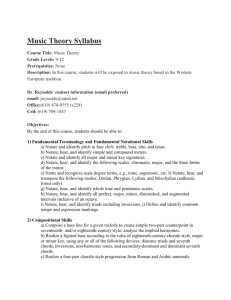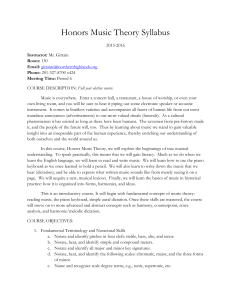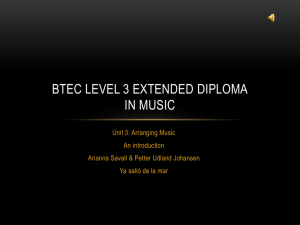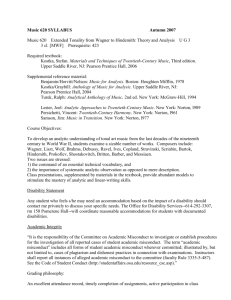HONORS MUSIC THEORY SYLLABUS
advertisement
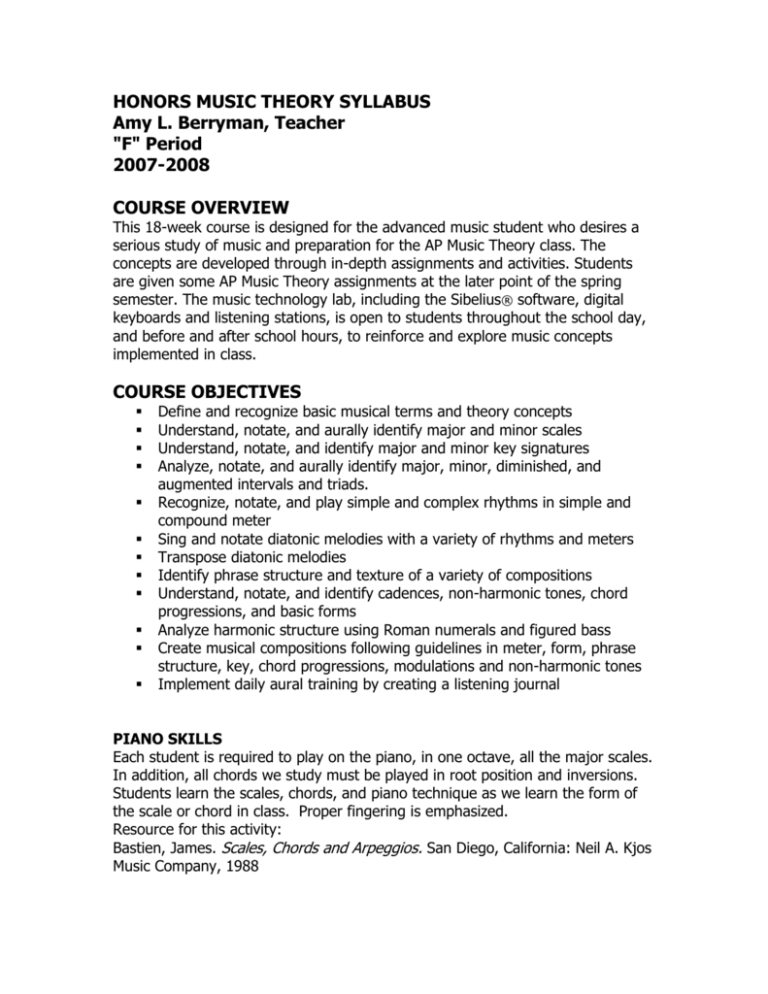
HONORS MUSIC THEORY SYLLABUS Amy L. Berryman, Teacher "F" Period 2007-2008 COURSE OVERVIEW This 18-week course is designed for the advanced music student who desires a serious study of music and preparation for the AP Music Theory class. The concepts are developed through in-depth assignments and activities. Students are given some AP Music Theory assignments at the later point of the spring semester. The music technology lab, including the Sibelius® software, digital keyboards and listening stations, is open to students throughout the school day, and before and after school hours, to reinforce and explore music concepts implemented in class. COURSE OBJECTIVES Define and recognize basic musical terms and theory concepts Understand, notate, and aurally identify major and minor scales Understand, notate, and identify major and minor key signatures Analyze, notate, and aurally identify major, minor, diminished, and augmented intervals and triads. Recognize, notate, and play simple and complex rhythms in simple and compound meter Sing and notate diatonic melodies with a variety of rhythms and meters Transpose diatonic melodies Identify phrase structure and texture of a variety of compositions Understand, notate, and identify cadences, non-harmonic tones, chord progressions, and basic forms Analyze harmonic structure using Roman numerals and figured bass Create musical compositions following guidelines in meter, form, phrase structure, key, chord progressions, modulations and non-harmonic tones Implement daily aural training by creating a listening journal PIANO SKILLS Each student is required to play on the piano, in one octave, all the major scales. In addition, all chords we study must be played in root position and inversions. Students learn the scales, chords, and piano technique as we learn the form of the scale or chord in class. Proper fingering is emphasized. Resource for this activity: Bastien, James. Scales, Chords and Arpeggios. San Diego, California: Neil A. Kjos Music Company, 1988 ASSESSMENT Homework Dictations Quizzes Tests/Exam Sight-Singing Composition 20% (Includes listening log, smaller compositions) 15% 20% 20% 10% 15% Homework is usually due at the beginning of each class. There are point deductions for work completed past the due date with unexcused explanations or absences. For sight-singing assessment with quizzes or tests, students schedule individual appointments with the teacher during study halls, lunch, and/or before or after school. Depending on the climate of the class, sometimes students will sight-sing for each other, listening for pitch and rhythm accuracy, as an assignment. PRIMARY TEXTBOOK Kostka, Stefan, and Dorothy Payne. Tonal Harmony with an Introduction to Twentieth Century Music, 5th ed. New York: McGraw-Hill, 2004 Kostka, Stefan, and Dorothy Payne. Tonal Harmony with an Introduction Twentieth Century Music Workbook, 5th ed. New York: McGraw-Hill, 2004 Kostka, Stefan, and Dorothy Payne. Tonal Harmony with an Introduction to Twentieth Century Music Audio CD, 5th ed. New York: McGraw-Hill, 2004 OTHER RESOURCES Baca, Mike, Willie Abrams, Manton Reece, Damon Clinkscales, Bobby Thomale and Mike Wolfinbarger. VitalSource Bookshelf Library, VitalSource Technologies, Inc. 2006 Benward, Bruce, and Marilyn Saker. Music in Theory and Practice, 7th ed. New York: McGraw-Hill 2003 Benward, Bruce, and Marilyn Saker. Music in Theory and Practice Workbook, 7th ed. New York: McGraw-Hill 2003 Finn, Ben, and Jonathan Finn. Sibelius 4.1 Software, Sibelius USA Inc, 2006 Ottman, Robert, and Nancy Rogers. Music for Sight Singing, 7th ed. Englewood Cliffs, NJ: Prentice Hall, 2007 Ricci Adams' Music Theory Website: www.musictheroy.net Turek, Ralph. Analytical Anthology of Music, 1st ed. New York: Alfred A Knopf, Inc. 1984 White, Gary. Music First! 3rd ed. New York: McGraw-Hill, 1996
